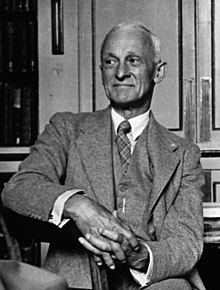Harvey Williams Cushing
| Harvey Cushing | |
|---|---|

Harvey Cushing in 1938
|
|
| Born |
Harvey Williams Cushing April 8, 1869 Cleveland, Ohio, US |
| Died | October 7, 1939 (aged 70) New Haven, Connecticut, US |
| Education |
Yale University Harvard Medical School Johns Hopkins Hospital |
| Occupation | Surgeon; Neurosurgeon |
| Years active | 1895–1935 |
| Known for | Pioneering brain surgery Cushing's syndrome |
| Spouse(s) | Katharine Stone Crowell (m. 1902–39) |
| Children | William Harvey Cushing Mary Benedict Cushing Betsey Maria Cushing Henry Kirke Cushing Barbara Cushing |
| Parent(s) | Kirke Cushing Bessie Williams |
Harvey Williams Cushing (April 8, 1869 – October 7, 1939) was an American neurosurgeon. A pioneer of brain surgery, he was the first person to describe Cushing's disease. Together with Ernest Sachs, he is known as the "father of neurosurgery."
Harvey Cushing was born in Cleveland, Ohio. His parents were Betsey M. Williams and Henry Kirke Cushing, a physician whose ancestors came to Hingham, Massachusetts, as Puritans in the 17th century. Harvey was the youngest of ten children.
As a child, Cushing attended the Cleveland Manual Training School which expanded his interest in science and medicine. The school’s emphasis on experimental training and a “physics-focused” approach to education played an important role in influencing Cushing towards a career in medical surgery. The school's manual dexterity training program also contributed to Cushing’s future success as a surgeon.
He graduated with an A.B. degree in 1891 from Yale University, where he was a member of Scroll and Key and Delta Kappa Epsilon (Phi chapter). He studied medicine at Harvard Medical School and earned his medical degree in 1895. Cushing completed his internship at Massachusetts General Hospital and then did a residency in surgery under the guidance of a famous surgeon, William Stewart Halsted, at the Johns Hopkins Hospital, in Baltimore.
After doing exceptional cerebral surgery abroad under Kocher at Bern and Sherrington at Liverpool, he began private practice in Baltimore. During his time with Kocher, he first encountered the Cushing reflex which describes the relationship between blood pressure and intracranial pressure. At the age of 32, he was made associate professor of surgery at Johns Hopkins Hospital, and was placed in full charge of cases of surgery of the central nervous system. Yet he found time to write numerous monographs on surgery of the brain and spinal column and to make important contributions to bacteriology. He made (with Kocher) a study of intracerebral pressure and (with Sherrington) contributed much to the localization of the cerebral centers. In Baltimore, he developed the method of operating with local anaesthesia, and his paper on its use in hernia gave him a European reputation. In 1911, he was appointed surgeon-in-chief at the Peter Bent Brigham Hospital in Boston. He became a professor of surgery at the Harvard Medical School starting in 1912. In 1913, he was made an honorary F.R.C.S. (London). He was elected a Fellow of the American Academy of Arts and Sciences in 1914. In 1915, before the Clinical Congress of Surgeons in Boston, he showed the possibility of influencing stature by operating on the pituitary gland.
...
Wikipedia
